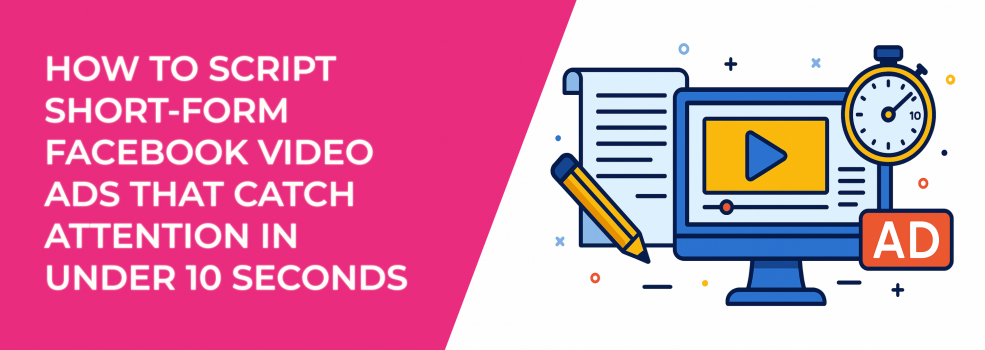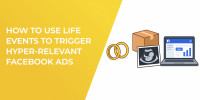Short-form Facebook video ads are now essential for brands that want visibility, engagement, and conversions. These fast, punchy creatives work because they match how people actually use Facebook and Instagram — quick taps, short attention spans, and feed-scrolling in silence.
If your Facebook video ad doesn’t deliver value in the first few seconds, it’s forgotten. Scripting these ads takes more than just trimming a longer script. It requires a focused approach built around how users behave in the feed.
Let’s walk through the key steps to writing a compelling short-form video ad script that captures attention in under 10 seconds.
1. Lead With the Hook — Immediately
The first second of your ad is critical. It’s the only guaranteed moment you’ll get, so don’t waste it with slow build-up or brand fluff. Start with something that visually or emotionally demands attention. The goal isn’t just to be noticed — it’s to trigger curiosity, recognition, or urgency fast enough to pause the scroll.
Viewer drop-off happens fast — over 60% leave by the 3-second mark. Hook early to keep them watching.
Here are a few ways to create a strong hook:
-
Show a transformation: Use a before-and-after format, time-lapse, or rapid reveal to make the viewer feel like they’re about to learn something useful.
-
Ask a bold question: “Still overpaying for [product]?” can stop a scroll faster than a regular brand message.
-
Use unexpected visuals: Fast motion, visual contrast, or a surprising image can work even without audio. Even a pattern break — like switching from real footage to animated text mid-shot — can jolt the viewer into paying attention.
-
Focus on a relatable pain point: The viewer should instantly recognize the problem you're highlighting.
Avoid starting with logos, introductions, or generic claims like “We’re a trusted solution provider.” None of that matters if the viewer scrolls away before hearing it. Lead with something that feels relevant, urgent, or useful. That might mean centering the product, but it could also mean centering the problem your product solves.
If you're stuck, try scripting three different versions of the first two seconds. Change the framing, the visual cue, or the tone. Then test them. In many cases, simply swapping out the hook can double or triple your ad’s retention rate — without touching the rest of the script.
Strong hooks aren’t just visual tricks — they tap into user psychology. Understanding how Facebook ads hook your audience in seconds can help you craft a more effective intro frame.
2. Write for Silent Viewing
Most users watch Facebook and Instagram videos with sound off — by default. That means your video ad needs to make sense even when it’s completely silent. If your message depends on narration, background music, or spoken product pitches, you risk losing the majority of your audience right away.
Try these tips for silent optimization:
-
Use on-screen text to highlight key benefits and CTAs. Avoid long paragraphs — 3–6 words per frame works best. For example: “Tired eyes?” → “One drop. Five seconds.” → “See the difference.”
-
Add captions if the ad includes dialogue or testimonials. Tools like Meta’s built-in auto-captioning can help, but consider customizing the style and timing to match your visual rhythm.
-
Ensure visual clarity: Each second should communicate one clear idea. If you're showing a product demo, keep the background neutral. Use close-ups and clear motion to demonstrate actions, especially for tactile products like skincare, tools, or food.
-
Avoid visual clutter or background distractions. Every visual should either support the core message or stay out of the way.
Every frame should carry weight. If a user glances at your ad mid-scroll with no sound, they should still understand what’s happening and what to do next.
3. Keep the Script Conversational
Forget complex wording or industry jargon. A Facebook video ad script should sound like something a friend might say — clear, direct, and informal.
Effective ad copy uses:
-
Short sentences: Easier to read, process, and repeat. They're also better suited for text overlays that appear on screen in sync with visuals. Think one idea per sentence — max.
-
Natural language: Write how your customers talk, not how your brand wants to sound. Ads that mirror the customer’s voice feel familiar — and familiarity builds trust.
-
Action verbs: Words like “shop,” “tap,” “save,” “clean,” and “try” encourage movement. Passive phrasing gets ignored. Direct phrasing gets clicks.
Here’s an example of natural versus generic phrasing:
-
Less effective: “We provide innovative productivity solutions for busy professionals.”
-
More effective: “Too many tabs? Try the app that keeps your day in one place.”
Other tips to keep it conversational:
-
Use contractions like “you’ll,” “don’t,” and “we’re” — they soften the tone.
-
Ask questions to create quick interaction. Even rhetorical ones. Example: “Sick of overpaying for skincare?”
-
Sound like the platform — Facebook and Instagram are casual spaces. Your ad should feel native to the feed, not like a script from a boardroom.
Keep in mind, every extra word risks losing attention. Before you finalize your script, read it aloud. If it feels stiff or overly formal, trim it. Rewrite it like a text message, not a brochure.
4. Show Results, Not Features
In a short-form Facebook video ad, there’s no time for deep explanations. Technical specs, product history, and brand mission statements all take a backseat. What viewers want — and what performs best — is clarity on one thing: what’s in it for them.
Frame the value clearly:
-
Start with the result: “Whiter teeth in 3 days,” not “New whitening formula.” Lead with the win.
-
Use numbers and timeframes: These add credibility and urgency. Compare these two: "Feel better, faster” vs. “Fall asleep 40% faster in your first week.” One is vague, the other measurable, and measurable results drive action.
-
Show product in use: Let visuals do the explaining while text reinforces the benefit. Add short text overlays to point out the payoff: “Done in 3 clicks,” “No mess,” “Zero setup.”
- Keep the message simple: “This saves time,” “This saves money,” or “This solves a daily headache.” These types of messages perform better than product overviews or claims of innovation.
At the end of the day, people don’t buy features. They buy better mornings, easier workflows, faster routines, or fewer headaches. Your ad should reflect that — not with long explanations, but with fast, visual proof that the result is worth their click.
If you're launching a new product, prioritize clear value delivery over feature checklists. These best practices for promoting a product on Facebook will help you position your ad from the user’s point of view.
5. Guide the Viewer to One Clear Action
Don’t assume viewers know what to do after watching. Your script should end with a clean, confident call-to-action (CTA).
Effective CTAs:
-
Are direct: “Download now,” “Tap to order,” or “Get it today.” Viewers respond best to simple, action-first language. Use clear verbs that tell them exactly what happens next:
-
Match the tone of the ad: If the ad feels personal, keep the CTA warm and simple. A CTA like “Find your match” or “Take the first step” might work better than “Buy now” in that context.
-
Make it appear on screen: Reinforce CTAs with text and motion (button animation, swipe gesture, etc.). Viewers should see what to do even if they’re watching silently.
-
Fit the funnel stage: For cold audiences, invite them to learn more. For retargeting, invite them to buy.
Also, make sure your landing page matches the promise of your CTA. If your ad says “Book a demo,” the viewer shouldn’t land on a homepage — they should land on a booking form. Any mismatch between the ad and destination can hurt conversion rates.
6. Test Variations — Especially the First 3 Seconds
Your ad’s intro has the biggest impact on performance. That’s where testing can lead to the biggest gains.
What to test:
-
Different hooks: Swap out the first line or image. A different emotion or claim might land better.
-
Visual pacing: Try a faster cut or a simpler background.
-
CTAs: A subtle tweak can improve conversions. “Try free” might outperform “Buy now.”
-
Text overlays: Some messages work better emphasized with bold, timed text.
-
Thumbnail and preview frame: Even auto-play videos can be influenced by the initial preview frame.
Track metrics like:
-
3-second and 15-second view rates — These tell you where viewers are dropping off.
-
ThruPlay completion rate — Useful for gauging how well the creative holds attention.
-
CTR (Click-through rate) — A strong signal that your CTA and message are landing.
-
Cost per result — Ultimately, the most important metric for measuring creative efficiency.
Facebook’s performance data will show what holds attention and what gets clicks. Keep iterating based on real viewer behavior.
If you're unsure where to start testing — whether it's visuals, messaging, or targeting — here’s a guide on what to test first in your Facebook campaigns and why it matters.
7. Build With Mobile in Mind
Most Facebook and Instagram users are on mobile. Your script and visuals should reflect that.
Mobile-friendly ad scripting means:
-
Framing the subject tightly: Avoid wide shots with too much empty space.
-
Using vertical or square formats: These fill the screen more effectively.
-
Showing action quickly: Don’t wait to reveal value — it should be visible within the first second.
-
Test with and without Wi-Fi: Low-quality mobile connections can affect load time and playback.
Mobile is where attention happens — or doesn’t. Your script, visuals, and pacing all need to respect how people consume content on the go. If your ad feels built for mobile first, not just adapted for it, you'll see the difference in performance.
Final Thoughts
A great short-form Facebook video ad does one thing well — it holds attention long enough to deliver a clear message.
Every second matters. Every word matters. Focus on showing value fast, staying visual, and guiding the viewer toward a specific action.
If you create content built around how users actually interact with Facebook and Instagram, your ads will not only perform better — they’ll feel natural to the platform.

